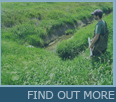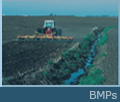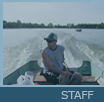"Water, the hub of life.
Water is its matter and matrix, mother and medium.
Water is the most extraordinary substance!
Practically all its properties are anomalous, which enabled life to use it as building material for its machinery.
Life is water dancing to the tune of solids."
- Albert Szent-Gyorgyi (1972)
..........................................................................
Duck Days
The sun was hot but the games were cool at Duck Days 2008! Kids got the chance to learn about wetland plants and animals while playing Springo Wetland Bingo and discovered that it's more difficult to repair a damaged ecosystem than to protect it in its original condition by putting together Habitat Puzzles. There was also plenty of information for adults on how to help improve water quality and demonstrations on how we measure water quality.
..........................................................................
1st Annual Crystal Loon Mills Viewer's Choice
Photography & Art Contest
Watershed residents and local lake admirers submitted their favorite photographs and drawings of Crystal, Loon, and Mills and the wildlife and recreational opportunities the lakes provide. Artwork was on display at the Centennial Student Union at MSUM and winners were chosen by the viewing public. We hope to see all of this year's artists back again next year, joined by their friends and neighbors. Many thanks to our great sponsors who helped make the 1st Annual Photo & Art Contest a smashing success!
..........................................................................
Best Management Practice Tours
Citizens got the chance to check out some BMPs in action during our summer field tours. The first tour, out to the University of MN's field research station at Lamberton, showcased wetland and drainage ditch water quality treatment options. On the second tour, Lake Crystal residents showed off their rain gardens and got the opportunity to see the equipment used by Crystal Valley Co-Op for Nutrient Management. We are looking forward to doing follow-up tours with our partners and citizens next spring to see the progress they've made with their best practices!
Lamberton Tour
Rain Garden Tour
..........................................................................
Water Quality Monitoring Activities
Monitoring the water quality of both County Ditch 56 (CD 56) and the lakes (Crystal, Loon, and Mills) is an integral part in evaluating how clean or dirty the water is. Water testing parameters are related to health, safety and suitability for recreation. Monitoring activities also help evaluate the impact of best practices on water quality throughout the watershed.
CD 56
Crystal Lake
Loon Lake
Mills Lake
..........................................................................
Graduate Research Project: Phosphorus Removal by Sago Pondweed
For his thesis project, grad assistant Matt Ribikawskis is transplanting submerged aquatic plants (Sago pondweed) into 4 fencing structures throughout Crystal Lake. The project's purpose is to utilize native plants as a way to reduce and remove in-lake phosphorus, to model the number of plants needed to significantly reduce in-lake phosphorus levels, and to provide larval and juvenile fish habitat. Sago pondweed is native to Crystal Lake; the fence structures are built to help keep (invasive) carp from uprooting the vegetation. Matt has completed his first sampling season during the 2008 summer and will be completing a second sampling season during the 2009 summer.
..........................................................................
Rain Barrel Pick-up Event
Citizens came out on a suitably rainy morning to pick up their rain barrels and help conserve water as it runs off their roofs and through their gutters.
..........................................................................
Harmful Algal Blooms
Freshwater harmful algal blooms (HAB) are comprised of algae that either create health hazards for humans and/or animals or cause deterioration of water quality or aesthetic/ recreational values. By far the most problematic group, and most researched, of freshwater HABs are the cyanobacteria, (sometimes called blue-green algae), which form high biomass blooms and/or produce toxins, as well as foul taste-and-odor compounds, and have caused human illness, animal mortalities, and adverse ecosystem and economic impacts in the U.S. and worldwide. The most prominent toxin producing species in the Crystal and Loon algal blooms is microsystis. Other freshwater HAB taxa cause harm either by producing toxins that kill fish and other aquatic organisms or by forming high biomass blooms that can cause hypoxia (low dissolved oxygen) and degrade water quality in other ways. (Source information from WHOI Freshwater Harmful Algal page: (http://www.whoi.edu/redtide/page.do?pid=15775)
|








